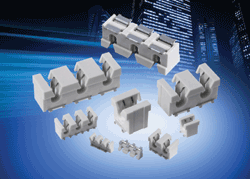The 3 Rs of IDCs: reliability, repeatability, reparability
Insulation displacement connectors remain a reliable, cost effective alternative to crimp-to-wire and hard-soldering wires
BY TOM ANDERSON
AVX, Fountain Inn, SC
www.avx.com
Even after more than 50 years in the marketplace, insulation displacement connectors (IDCs) continue to prove themselves in new and demanding applications, such as automotive safety systems, solid-state lighting (SSL), and industrial sensors and controls. IDCs have provided a cost-effective and reliable alternative to crimp-to-wire and hard-soldering wires to a PCB.
Making reliable connections
The harsh-environment IDC contact design offers reliability over time, temperature, and vibration with a repeatable/consistent termination process while allowing for reparability if needed. The contact design methodology takes into account critical design parameters, variables, and environmental conditions to create a robust and reliable contact system that continues to outperform today’s performance requirements.
The IDC termination provides a gas-tight connection with inherent spring characteristics built right into the contact design. IDC contacts are precision stamped from a phosphor bronze material with a wire slot that matches a specific wire gauge. During the wire insertion/termination process, this contact pierces and displaces the wire insulation, eliminating the need for stripping.
This same shearing motion also wipes away any oxides and deforms the conductor to create a gas-tight connection. The opposing contacts put significant force on the wire, providing critical spring characteristics to ensure no relaxation even after years of harsh environments and thermal shock. By design, the contact can also accept both solid and stranded wires, which allows it to be used in a broader range of applications.
Discrete wire terminations to a PCB have not changed much over the years. Historically these have been hard soldered or a crimp-to-wire cable assembly with a corresponding board-level header. While reliable, both of these processes add cost and process variations. This was the main driving force for connector companies to reintroduce the IDC contact system for harsh environments.
The electrical connections in automotive, industrial, and SSL applications see extreme harsh environments, which can adversely affect the mechanical and electrical stability of a wire-to-board connection. IDC contacts have been automotive qualified for several years in airbag, engine, and transmission control units. This is an unbelievable testimony as to how well this contact can perform in mission-critical systems.
Improvements in design
The development of advanced insulation displacement connector technology has led to a new series of products focused on the industrial and SSL markets, where simple, reliable, and modular connectors are needed to solve the broad application requirements of terminating discrete wires to a PCB. Designed to support 14 to 28-AWG wires, new insulation displacement connectors incorporate a dual contact configuration to handle up to 15 A of current with redundant gas-tight terminations for each wire. Mechanical stability on the PCB is typically provided by two independent SMT solder tails, ensuring reliability in harsh environments. The high-temperature insulator enables easy SMT placement and integral strain relief of the wire insulation to protect the electrical connection during shock and vibration (see Fig. 1 ).

This IDC connector family features high-temperature insulators.
Additional design enhancements have yielded insulation displacement connectors that are end stackable to support many wire-stranding configurations, as well as both Teflon- and PVC-jacketed wires. Custom and unique wires can be tested to confirm their compliance to a specific IDC contact size for ensured reliability. Supporting temperature requirements from 40 up to 125C, IDCs have been tested up to 50 g’s of shock. Termination/locking caps are available for very extreme vibration requirements in transportation or aircraft applications. In addition, simple insertion tools are available for the wire termination process.
New applications driven by size have emerged that demand long-term ruggedness and reliability. To meet these demands, IDC contacts have been pulled out of the connector body to act as stand-alone contacts. This offers the same level of performance, just in a smaller and more placement flexible format.
In low-vibration or static applications the stand-alone contact offers significant cost advantages over the full connectors. For harsh or high-vibration applications, there is an optional termination/locking cap. To date, two sizes of this individual contact have been developed: 18-24 AWG and, smaller, 22 to 24 AWG, which is 2.5 x 2.5 mm and 2.75 mm high.
Customer acceptance of this cost-effective and reliable connector system has migrated into additional wire gauges. Insulation displacement connectors can support 14 to 28 AWG handling up to 15 A. Additional concepts are currently under development to support emerging applications needing the same basic themes: reliability, repeatability, and reparability. ■
Advertisement
Learn more about AVX





